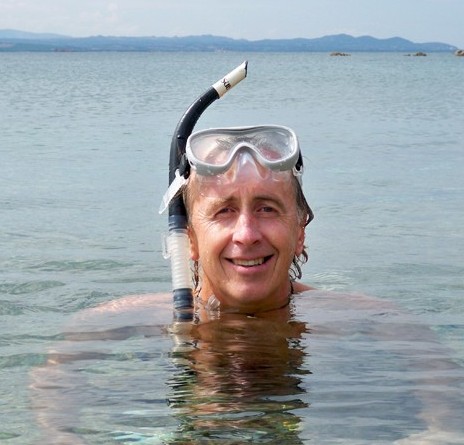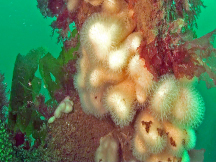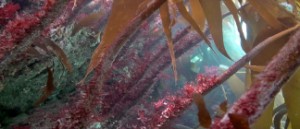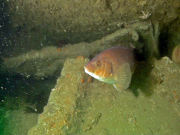Marine Life & Conservation Blogs
Jumping Sunfish

It’s been quite a few years since I have dived in the UK. I guess in many ways I have been spoilt with tropical destinations. I decided to leave my old drysuit in the cupboard and embrace this lovely summer with a wet suit. As it turned out, I almost regretted it but the dive was quite shallow and not too cold. I was diving with Mark Milburn from Atlantic Scuba near Falmouth who knows the coast here like the back of his hand and was taking us to the wreck of the Hera where I was giving an introductory session for my underwater video courses.
 We were gradually getting ready to go in the water when I saw out of the corner of my eye a good sized fish jumping out of the water. As I shouted, all four people on the boat looked around only to see the remains of a splash where the fish had disappeared. There was something odd about it. The shape was wrong and the splash slightly different from any fish I might have expected to see leap from the water. Then as we were talking about what it could have been, it jumped again. This time we all saw it and to my delight recognised it immediately as a very large Sun Fish (mola mola). It came fully out of the water and flopped back in on its side. I had no idea they did that. I have since looked up other possible instances on the web and Wikipedia tell me that yes they do this occasionally and recount a story of a young lad being knocked over in his boat while fishing with his family off the coast of Pembrokeshire, Wales. http://news.bbc.co.uk/1/hi/wales/4192566.stm The 30kg fish had leapt from the water and landed on top of him. Amazing. Wikipedia has a picture of 1600Kg sunfish caught off South Africa. We don’t see them that size any more – same old story of over fishing to near extinction. Its specific name, mola, is Latin for “millstone”, which the fish resembles because of its grey colour, rough texture, and rounded body. Its common English name, sunfish, refers to the animal’s habit of sunbathing at the surface of the water.
We were gradually getting ready to go in the water when I saw out of the corner of my eye a good sized fish jumping out of the water. As I shouted, all four people on the boat looked around only to see the remains of a splash where the fish had disappeared. There was something odd about it. The shape was wrong and the splash slightly different from any fish I might have expected to see leap from the water. Then as we were talking about what it could have been, it jumped again. This time we all saw it and to my delight recognised it immediately as a very large Sun Fish (mola mola). It came fully out of the water and flopped back in on its side. I had no idea they did that. I have since looked up other possible instances on the web and Wikipedia tell me that yes they do this occasionally and recount a story of a young lad being knocked over in his boat while fishing with his family off the coast of Pembrokeshire, Wales. http://news.bbc.co.uk/1/hi/wales/4192566.stm The 30kg fish had leapt from the water and landed on top of him. Amazing. Wikipedia has a picture of 1600Kg sunfish caught off South Africa. We don’t see them that size any more – same old story of over fishing to near extinction. Its specific name, mola, is Latin for “millstone”, which the fish resembles because of its grey colour, rough texture, and rounded body. Its common English name, sunfish, refers to the animal’s habit of sunbathing at the surface of the water.
 With the Sunfish now in the back of our minds we dived down to the wreck. Visibility wasn’t too great but as the wreck came into view I was greeted by a lovely array of bright Dead Mans Fingers with their delicate polyps gathering food in the slight current. I had forgotten just how spectacular they can be.
With the Sunfish now in the back of our minds we dived down to the wreck. Visibility wasn’t too great but as the wreck came into view I was greeted by a lovely array of bright Dead Mans Fingers with their delicate polyps gathering food in the slight current. I had forgotten just how spectacular they can be.
Moving on across the wreck site I saw a large wrasse disappear into the kelp and under a piece of wreck plating. I stuck my head in to look for it. A miniature forest of kelp stalks and fronds filtered the sun light and gave a feeling of a secret world, quiet and protected from the sea above. It was enchanting. Kelp is used for so many things in our society, from food proteins to cosmetics. It is used on the land for fertiliser and as a food in its own right. It is also and more importantly a stable ecosystem for many marine species.
A brief search revealed the wrasse taking refuge from me in the wreck’s man made cave. It was quite relaxed and I would have liked to spend more time with it but as my air was short I had to make my way back to the shot line for my 3 minute safety stop.
There is so much life here. Of course the water is cold and the visibility is often poor, but the diversity of life in our temperate waters is immense.
On the way back into Falmouth we noticed a small Dory type boat circling with the people in it pointing to something in the water. We headed over to see what was happening and saw a very small Basking Shark trying to head away. Seeing us, the people in the Dory obviously knew they were doing wrong by harassing the shark and so turned away and disappeared. Listed as endangered in the North East Atlantic Ocean, basking sharks are now protected by UK and international law. In the UK basking sharks are afforded full protection from intentional capture or disturbance in British waters (up to 12 miles offshore) under the 1998 Schedule 5 listing of the Wildlife and Countryside Act (1981). It makes sense really, so if you see these gentle sharks while out boating, please give them space. If they come to you then all well and good. It is a wonderful wildlife encounter when they do come near so please drive slowly and respectfully giving the shark plenty of room to avoid you if it feels threatened.
(Except for the Sun Fish, the photos in this article are taken from video frames on a Sony XR550.)
Marine Life & Conservation Blogs
Creature Feature: Dusky Shark

 In this series, the Shark Trust will be sharing amazing facts about different species of sharks and what you can do to help protect them.
In this series, the Shark Trust will be sharing amazing facts about different species of sharks and what you can do to help protect them.
This month we’re taking a look at the Dusky Shark, a highly migratory species with a particularly slow growth rate and late age at maturity.
Dusky sharks are one of the largest species within the Carcharhinus genus, generally measuring 3 metres total length but able to reach up to 4.2 metres. They are grey to grey-brown on their dorsal side and their fins usually have dusky margins, with the darkest tips on the caudal fin.
Dusky Sharks can often be confused with other species of the Carcharhinus genus, particularly the Galapagos Shark (Carcharhinus galapagensis). They have very similar external morphology, so it can be easier to ID to species level by taking location into account as the two species occupy very different ecological niches – Galapagos Sharks prefer offshore seamounts and islets, whilst duskies prefer continental margins.
Hybridisation:
A 2019 study found that Dusky Sharks are hybridising with Galapagos Sharks on the Eastern Tropical Pacific (Pazmiño et al., 2019). Hybridisation is when an animal breeds with an individual of another species to produce offspring (a hybrid). Hybrids are often infertile, but this study found that the hybrids were able to produce second generation hybrids!
Long distance swimmers:
Dusky sharks are highly mobile species, undertaking long migrations to stay in warm waters throughout the winter. In the Northern Hemisphere, they head towards the poles in the summer and return southwards towards the equator in winter. The longest distance recorded was 2000 nautical miles!
Very slow to mature and reproduce:
The Dusky Shark are both targeted and caught as bycatch globally. We already know that elasmobranchs are inherently slow reproducers which means that they are heavily impacted by overfishing; it takes them so long to recover that they cannot keep up with the rate at which they are being fished. Dusky Sharks are particularly slow to reproduce – females are only ready to start breeding at roughly 20 years old, their gestation periods can last up to 22 months, and they only give birth every two to three years. This makes duskies one of the most vulnerable of all shark species.
The Dusky Shark is now listed on Appendix II of the Convention on the Conservation of Migratory Species (CMS), but further action is required to protect this important species.
Scientific Name: Carcharhinus obscurus
Family: Carcharhinidae
Maximum Size: 420cm (Total Length)
Diet: Bony fishes, cephalopods, can also eat crustaceans, and small sharks, skates and rays
Distribution: Patchy distribution in tropical and warm temperate seas; Atlantic, Indo-Pacific and Mediterranean.
Habitat: Ranges from inshore waters out to the edge of the continental shelf.
Conservation status: Endangered.
For more great shark information and conservation visit the Shark Trust Website
Images: Andy Murch
Diana A. Pazmiño, Lynne van Herderden, Colin A. Simpfendorfer, Claudia Junge, Stephen C. Donnellan, E. Mauricio Hoyos-Padilla, Clinton A.J. Duffy, Charlie Huveneers, Bronwyn M. Gillanders, Paul A. Butcher, Gregory E. Maes. (2019). Introgressive hybridisation between two widespread sharks in the east Pacific region, Molecular Phylogenetics and Evolution 136(119-127), https://doi.org/10.1016/j.ympev.2019.04.013.
Marine Life & Conservation Blogs
Creature Feature: Undulate Ray

 In this series, the Shark Trust will be sharing amazing facts about different species of sharks and what you can do to help protect them.
In this series, the Shark Trust will be sharing amazing facts about different species of sharks and what you can do to help protect them.
This month we’re looking at the Undulate Ray. Easily identified by its beautiful, ornate pattern, the Undulate Ray gets its name from the undulating patterns of lines and spots on its dorsal side.
This skate is usually found on sandy or muddy sea floors, down to about 200 m deep, although it is more commonly found shallower. They can grow up to 90 cm total length. Depending on the size of the individual, their diet can range from shrimps to crabs.
Although sometimes called the Undulate Ray, this is actually a species of skate, meaning that, as all true skates do, they lay eggs. The eggs are contained in keratin eggcases – the same material that our hair and nails are made up of! These eggcases are also commonly called mermaid’s purses and can be found washed up on beaches all around the UK. If you find one, be sure to take a picture and upload your find to the Great Eggcase Hunt – the Shark Trust’s flagship citizen science project.
It is worth noting that on the south coasts, these eggcases can be confused with those of the Spotted Ray, especially as they look very similar and the ranges overlap, so we sometimes informally refer to them as ‘Spundulates’.
Scientific Name: Raja undulata
Family: Rajidae
Maximum Size: 90cm (total length)
Diet: shrimps and crabs
Distribution: found around the eastern Atlantic and in the Mediterranean Sea.
Habitat: shelf waters down to 200m deep.
Conservation Status : As a commercially exploited species, the Undulate Ray is a recovering species in some areas. The good thing is that they have some of the most comprehensive management measures of almost any elasmobranch species, with both minimum and maximum landing sizes as well as a closed season. Additionally, targeting is entirely prohibited in some areas. They are also often caught as bycatch in various fisheries – in some areas they can be landed whilst in others they must be discarded.
IUCN Red List Status: Endangered
For more great shark information and conservation visit the Shark Trust Website
Image Credits: Banner – Sheila Openshaw; Illustration – Marc Dando
-

 News3 months ago
News3 months agoHone your underwater photography skills with Alphamarine Photography at Red Sea Diving Safari in March
-

 News3 months ago
News3 months agoCapturing Critters in Lembeh Underwater Photography Workshop 2024: Event Roundup
-

 Marine Life & Conservation Blogs3 months ago
Marine Life & Conservation Blogs3 months agoCreature Feature: Swell Sharks
-

 Blogs2 months ago
Blogs2 months agoMurex Resorts: Passport to Paradise!
-

 Blogs2 months ago
Blogs2 months agoDiver Discovering Whale Skeletons Beneath Ice Judged World’s Best Underwater Photograph
-

 Marine Life & Conservation2 months ago
Marine Life & Conservation2 months agoSave the Manatee Club launches brand new webcams at Silver Springs State Park, Florida
-

 Gear Reviews3 months ago
Gear Reviews3 months agoGear Review: Oceanic+ Dive Housing for iPhone
-

 Gear Reviews2 weeks ago
Gear Reviews2 weeks agoGEAR REVIEW – Revolutionising Diving Comfort: The Sharkskin T2 Chillproof Suit

























